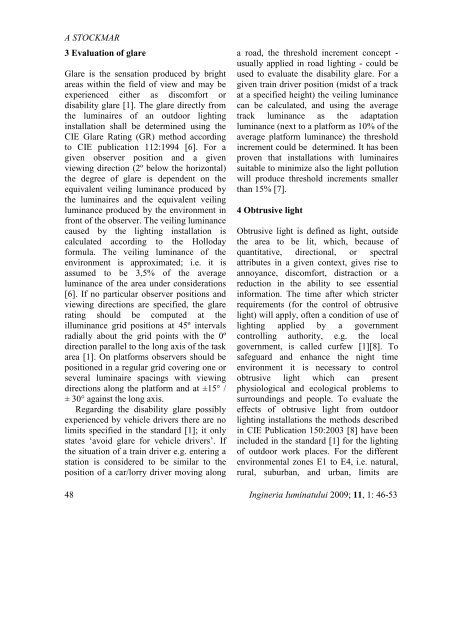ingineria iluminatului - Journal of Lighting Engineering - Prof. Florin ...
ingineria iluminatului - Journal of Lighting Engineering - Prof. Florin ...
ingineria iluminatului - Journal of Lighting Engineering - Prof. Florin ...
You also want an ePaper? Increase the reach of your titles
YUMPU automatically turns print PDFs into web optimized ePapers that Google loves.
A STOCKMAR<br />
3 Evaluation <strong>of</strong> glare<br />
Glare is the sensation produced by bright<br />
areas within the field <strong>of</strong> view and may be<br />
experienced either as discomfort or<br />
disability glare [1]. The glare directly from<br />
the luminaires <strong>of</strong> an outdoor lighting<br />
installation shall be determined using the<br />
CIE Glare Rating (GR) method according<br />
to CIE publication 112:1994 [6]. For a<br />
given observer position and a given<br />
viewing direction (2º below the horizontal)<br />
the degree <strong>of</strong> glare is dependent on the<br />
equivalent veiling luminance produced by<br />
the luminaires and the equivalent veiling<br />
luminance produced by the environment in<br />
front <strong>of</strong> the observer. The veiling luminance<br />
caused by the lighting installation is<br />
calculated according to the Holloday<br />
formula. The veiling luminance <strong>of</strong> the<br />
environment is approximated; i.e. it is<br />
assumed to be 3,5% <strong>of</strong> the average<br />
luminance <strong>of</strong> the area under considerations<br />
[6]. If no particular observer positions and<br />
viewing directions are specified, the glare<br />
rating should be computed at the<br />
illuminance grid positions at 45º intervals<br />
radially about the grid points with the 0º<br />
direction parallel to the long axis <strong>of</strong> the task<br />
area [1]. On platforms observers should be<br />
positioned in a regular grid covering one or<br />
several luminaire spacings with viewing<br />
directions along the platform and at ±15° /<br />
± 30° against the long axis.<br />
Regarding the disability glare possibly<br />
experienced by vehicle drivers there are no<br />
limits specified in the standard [1]; it only<br />
states ‘avoid glare for vehicle drivers’. If<br />
the situation <strong>of</strong> a train driver e.g. entering a<br />
station is considered to be similar to the<br />
position <strong>of</strong> a car/lorry driver moving along<br />
a road, the threshold increment concept -<br />
usually applied in road lighting - could be<br />
used to evaluate the disability glare. For a<br />
given train driver position (midst <strong>of</strong> a track<br />
at a specified height) the veiling luminance<br />
can be calculated, and using the average<br />
track luminance as the adaptation<br />
luminance (next to a platform as 10% <strong>of</strong> the<br />
average platform luminance) the threshold<br />
increment could be determined. It has been<br />
proven that installations with luminaires<br />
suitable to minimize also the light pollution<br />
will produce threshold increments smaller<br />
than 15% [7].<br />
4 Obtrusive light<br />
Obtrusive light is defined as light, outside<br />
the area to be lit, which, because <strong>of</strong><br />
quantitative, directional, or spectral<br />
attributes in a given context, gives rise to<br />
annoyance, discomfort, distraction or a<br />
reduction in the ability to see essential<br />
information. The time after which stricter<br />
requirements (for the control <strong>of</strong> obtrusive<br />
light) will apply, <strong>of</strong>ten a condition <strong>of</strong> use <strong>of</strong><br />
lighting applied by a government<br />
controlling authority, e.g. the local<br />
government, is called curfew [1][8]. To<br />
safeguard and enhance the night time<br />
environment it is necessary to control<br />
obtrusive light which can present<br />
physiological and ecological problems to<br />
surroundings and people. To evaluate the<br />
effects <strong>of</strong> obtrusive light from outdoor<br />
lighting installations the methods described<br />
in CIE Publication 150:2003 [8] have been<br />
included in the standard [1] for the lighting<br />
<strong>of</strong> outdoor work places. For the different<br />
environmental zones E1 to E4, i.e. natural,<br />
rural, suburban, and urban, limits are<br />
48 Ingineria Iuminatului 2009; 11, 1: 46-53
















